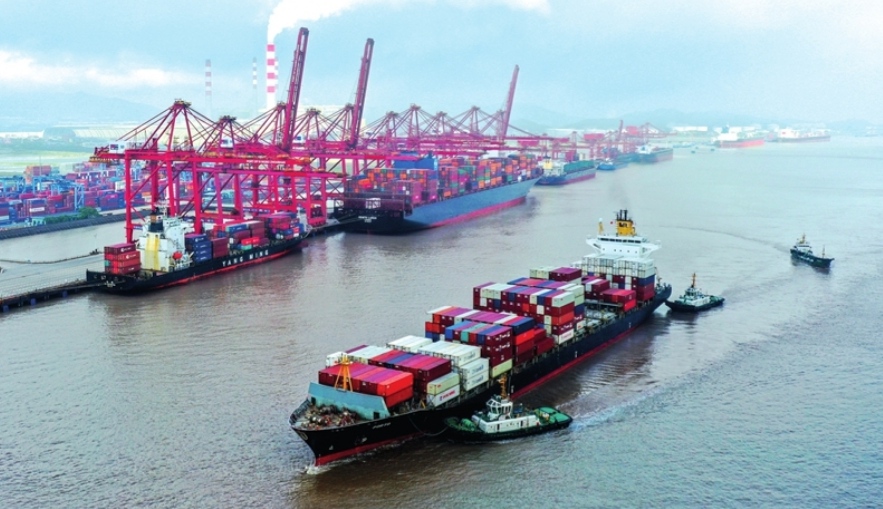Chinese firms likely to lose fresh export orders

Cargo ships carrying containers pile up at the Ningbo Zhoushan Port in Ningbo, East China’s Zhejiang Province.
US firms placing fresh orders on Chinese manufactures has hit another Low in recent days, putting pressure on bilateral trade between China and the US. This has hit the Chinese producers and manufactures hard and exporters are forced to slow down production as new orders are scares. All this amid soaring freight rates and container shortages ahead of the Christmas and Thanksgiving holidays, according to industry insiders is going to hit Chinese economy quite seriously.
On top of all The above, there are also heavy Port congestion in the US due to Civic slowdown. This thrown supply chains between China and the US into great uncertainty, with some industry insiders saying the deteriorating situation will further disrupt their business. Exptterts also warned that the situation could continue into next year.
A home appliance producer in South China’s Guangdong Province, who has been doing trade with the US for nearly 10 years, said that the both export orders and logistics hurdles have worsened in recent months due to congestion on the US West Coast.
In fact Chinese firms are having products valued at hundreds of thousands of yuan waiting for shipment at domestic ports because they don’t have enough export orders and also they couldn’t find enough containers and ships to get to the US.
Global logistics company Maersk said that the ports of Los Angeles and Long Beach have seen congestion worsen recently, with vessel waiting times rising from five days to 12. The waiting time is five days at Savannah, Georgia and 15 days at Seattle, Washington. May be some of it is deliberate by Port Unions who oppose any kind of trade with China.
In terms of Asia-North America lanes, capacity will remain low due to missed sailings caused by port congestion, and Maersk has deployed gap loaders on both the East and West coasts to secure network capacity, it said.
As of Friday evening, 44 container ships were berthed outside the ports of Los Angeles and Long Beach, California, breaking the previous record of 40 set in early February, according to Bloomberg data. The average waiting time for ships has risen to 7.6 days from 6.2 in mid-August.
Even for products that have already reached the US, they have not been delivered to clients because of a truck driver shortage, which means the risks of contract default since the deadlines for delivery are getting near.
New orders are not forthcoming because of the logistics hurdle, and low demands – about 50 percent less than last year in terms of orders.
Another trader in Yiwu, East China’s Zhejiang Province has stopped taking new orders for Christmas, partially due to the port congestion.
Shipments of goods for the Christmas and Thanksgiving holidays ended earlier than usual this year, the trader said, because of the rising uncertainty in logistics and orders.
“The waiting time for a ship to US ports has been extended for another week, and it’s even a longer time until the goods are delivered to clients after arriving at the port,” said the person.
As recent coronavirus outbreaks at Chinese ports such as Yantian in Guangdong and Meishan port in Ningbo, Zhejiang – two major ports in China that have highlighted the global logistics hurdles – industry insiders said what has really weighed on trade is the failed containment of the epidemic in the US, and inefficient port operations.
At least seven of the 10 busiest ports in the US face regular congestion, according to industry information.
“The shortage of container truck drivers in the US, with less than 50 percent manpower, has left cargo at some ports unable to be pulled from the docks or other arriving ships,” said an independent shipping industry analyst in Shanghai.
Most of the congested ports in the US operate independently and thus lack effective coordination, with low flexibility when workers are on strike or absent.
With Thanksgiving, Christmas and other major holidays coming, the situation could become worse due to the rising port congestion that led to container shortages and higher freight rates, experts said.
The number of containers shipped from Asia to the US reached 1.71 million in July, up 10.6 percent year-on-year, setting a monthly record, according to data from Descartes Datamyne, a US research agency.
However, the US had a 40 percent imbalance gap, meaning that for every 10 containers brought in, only six were shipped out and four were stranded in the country.
The whole supply chain between China and USA has thus been disrupted very badly.




